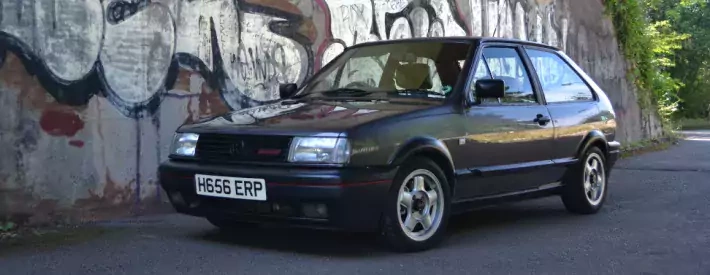The day I bought my first car (and still own it 22 years later)

Memories add life and value to even the most ordinary machinery. Having stuck around for 22 years, from my teens to now my late 30s, my first car has had a role in more than its fair share of those life-defining moments.
Ironically, this story could have been much shorter. In March 2000, with my 17th birthday looming and countless viewings of exhausted Mk2 Golfs behind us, my dad almost drove away without stopping when we arrived to find the Polo with its bonnet open. It was the polar opposite of the thinly polished wrecks we’d seen previously; faded plastics, sap-encrusted paint and enough dog hair woven into the upholstery to stuff a duvet, yet also straight, solid and mechanically sound beneath the grime. The previous owner was changing a headlight bulb.
I have loved cars for as long as I can remember, so I had spent months planning for this moment. Copies of Max Power, Fast Car and Performance VW magazines filled my head with ideas, my well-thumbed Demon Tweeks catalogue had helped me budget for them, and an afterschool job filing microfiche had raised the money I needed. The enthusiastic chirp of tyre on industrial estate car park as I released the clutch for the first time was the dawn of a rewarding reality. I’ll never forget how that felt.
The early 2000s were, in hindsight, a golden era for modifying. Cars were relatively simple and, with a basic toolkit, bolt-on parts and space to work, stepping up the performance, audio quality or visual impact was all very accessible. My Polo GT, with its revvy 75hp engine, short-ratio box and mini GTI styling, arrived to lukewarm reviews in 1990, but part-time wages, student loans and a lot of trial and error could address some of those shortcomings ten years later. I’m no mechanic, but I learned a lot.
Each change was thoroughly road tested. The Polo spent years as a workhorse, ferrying my dad to work, taking me and my brother to school, moving me to university and even collecting my girlfriend (now my wife) for our first date. Every summer I’d fill it with camping gear and spend weekends at Volkswagen shows, trading parts and making friends – many of whom I’m still in touch with today. That’s where I had my first ride in a Polo G40, and realised I’d been missing out.
The Mk2 Polo didn’t quite muscle in on the Golf or Corrado’s performance limelight, but G40s have a cult following. Its unique supercharger – with 40mmwide G-shaped internal vanes – boosted the 1,272cc engine to 113hp, and at only 830kg, this offered giant-killing potential. Magazine group tests showed in-gear acceleration times that could run rings around not only its rivals but the Corrado G60 too, and that’s before tuners had got involved. Incongruous, characterful and unusual (only 500 were sold here), I had to have one.
It took until 2005 for insurance premiums to become affordable, by which point the market was shrinking quickly. Falling prices had put the scruffiest G40s into unsympathetic hands, and classified ads were awash with bent bodyshells, blown superchargers and melted pistons. My GT, with its straight bodywork and G40-or better chassis spec, seemed like a comparatively safer foundation. So when a good engine turned up in Yorkshire, I folded the rear seats and brought it home to Cardiff in the boot. With help from a friend, the two-day engine swap in my parents’ garage almost doubled the Polo’s power output.
Forget the pub bragging rights, because the G40’s appeal is sensory. I’ve road tested countless faster cars, but few modern machines feel as excitable as a featherweight hatchback that’s near permanently (and also audibly) on boost. Mine puts out around 150hp thanks to its heavily ported supercharger and smaller pulley with toothed belts (which reduce slip at high revs and stress on its main bearings), while the bespoke ECU map runs larger injectors to cope with the extra boost. Modern hot hatch pace, but it feels even quicker.
That performance boost resulted in a change of mindset. Instead of pushing the mechanical parts any harder, I’ve focused on making use of its available power. The Quaife limited-slip differential should have been a factory option, I’ve added bigger brakes from a Mk2 Golf GTI 16v, downsized from 15-inch wheels to a set of 14-inch Revolution RFX, and fully adjustable suspension has allowed me to set the corner weights for track driving. The car I learned to drive in has lapped the Nürburgring, Castle Combe and Rockingham, slid across the skidpan at Porsche’s Silverstone Experience Centre and weaved through airfield sprint courses.
In the meantime, life has marched on around it. Although the Polo has retired from daily driver duty, it’s in regular use. It moved to the Midlands when I got my first job as a journalist, it’s featured as a staff project in Max Power and Performance VW magazines, and takes me to meetings and events all over the country. The lack of ISOFIX points curbed usage after I started a family, but with our new beltfixed booster seats it’s found a new life among the school run SUVs. My three kids are the third generation of Grants to commute in it.
On a wider scale, it seems I’m not the only person with memories attached to this era of car. Scarcity and sentimentality are steadily pushing prices up, even for niche models like the G40, and I’ve started to notice nods of approval and raised phone cameras from passing cars when I’m on the motorway. I’d class that as justification for its recent under-body restoration, preserving and protecting it for all-season usage and whichever of my kids eventually inherits it. Until then, I’m hoping we’ve got plenty of story-making years ahead of us.




